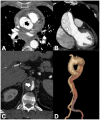MDCT Imaging of Non-Traumatic Thoracic Aortic Emergencies and Its Impact on Diagnosis and Management-A Reappraisal
- PMID: 35076599
- PMCID: PMC8788571
- DOI: 10.3390/tomography8010017
MDCT Imaging of Non-Traumatic Thoracic Aortic Emergencies and Its Impact on Diagnosis and Management-A Reappraisal
Abstract
Non-traumatic thoracic aorta emergencies are associated with significant morbidity and mortality. Diseases of the intimomedial layers (aortic dissection and variants) have been grouped under the common term of acute aortic syndrome because they are life-threatening conditions clinically indistinguishable on presentation. Patients with aortic dissection may present with a wide variety of symptoms secondary to the pattern of dissection and end organ malperfusion. Other conditions may be seen in patients with acute symptoms, including ruptured and unstable thoracic aortic aneurysm, iatrogenic or infective pseudoaneurysms, aortic fistula, acute aortic thrombus/occlusive disease, and vasculitis. Imaging plays a pivotal role in the patient's management and care. In the emergency room, chest X-ray is the initial imaging test offering a screening evaluation for alternative common differential diagnoses and a preliminary assessment of the mediastinal dimensions. State-of-the-art multidetector computed tomography angiography (CTA) provides a widely available, rapid, replicable, noninvasive diagnostic imaging with sensitivity approaching 100%. It is an impressive tool in decision-making process with a deep impact on treatment including endovascular or open surgical or conservative treatment. Radiologists must be familiar with the spectrum of these entities to help triage patients appropriately and efficiently. Understanding the imaging findings and proper measurement techniques allow the radiologist to suggest the most appropriate next management step.
Keywords: TEVAR; acute aortic syndrome; aorta; aortic aneurysm; aortic dissection; aortic emergencies; computed tomography angiography; emergency CT; imaging of the aorta; management.
Conflict of interest statement
The authors declare no conflict of interest.
Figures















References
-
- Lai V., Tsang W.K., Chan W.C., Yeung T.W. Diagnostic accuracy of mediastinal width measurement on posteroanterior and anteroposterior chest radiographs in the depiction of acute nontraumatic thoracic aortic dissection. Emerg. Radiol. 2012;19:309–315. doi: 10.1007/s10140-012-1034-3. - DOI - PMC - PubMed
Publication types
MeSH terms
LinkOut - more resources
Full Text Sources

